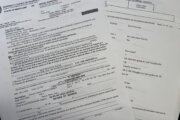Every corporation needs reliable access to capital to stay in business. Positive cash flow allows businesses to cover expenses, plan growth initiatives and reward long-term shareholders. Cash flow statements give investors an assessment of how companies utilize incoming cash.
“Cash flow statements are another term for a budget,” says Brian Kuhn, senior vice president and financial advisor at Wealth Enhancement Group. “Households typically have budgets, while companies have cash flow statements.”
[Sign up for stock news with our Invested newsletter.]
Corporate budgets go toward important investments, such as salaries, raw materials, ambitious projects, debt payments and shareholder dividends. Here are some critical things to know about cash flow statements:
— What is a cash flow statement?
— Why is a cash flow statement important?
— Key components of a cash flow statement.
— How corporations calculate cash flow.
— How to analyze cash flow statements.
— Useful cash flow metrics.
What Is a Cash Flow Statement?
A cash flow statement gives investors insights into how a company manages its cash and where the money goes. Janelle McCreary, wealth advisor at RMB Capital, offers a concise summary of how these statements work: “Cash flow statements show total cash inflows and outflows for a given time period.”
While a personal cash flow statement may contain someone’s salary and 1099 income, a corporate cash flow statement focuses on operating activities, investing activities and financing activities.
Excess cash flow acts like an emergency fund. These funds can go toward emergency expenses, acquisitions, dividends and other initiatives. More cash flow allows corporations to tap into more opportunities and remain financially solvent.
Why Is a Cash Flow Statement Important?
Investors can look at balance sheets and skim through a company’s earnings report to gauge how a company is performing. However, it’s also important to analyze a corporation’s cash flow statement.
Each new cash flow statement gives investors a pulse of the corporation’s financial health. Publicly traded corporations must release these reports every quarter alongside quarterly balance sheets. Investors receive a lot of information from cash flow statements, but some data points are more important than others.
Knowing how to interpret a cash flow statement can help you determine the long-term viability of an asset. Declining prospects within cash flow statements can often be precursors to lower earnings or stalled dividend growth. Cash flow statements can also help investors assess a dividend’s long-term sustainability and accurately predict dividend cuts before they happen.
Key Components of a Cash Flow Statement
A cash flow statement consists of numerous line items, but these line items fall neatly into a few categories. These are the components that make up a cash flow statement:
Cash Flow From Operating Activities
Cash flow from operating activities is the best indicator of a company’s long-term financial health. As you might expect, this type of cash flow measures how much cash a company generates from its operating activities.
Each time Apple Inc. (ticker: AAPL) sells an iPhone, the company’s cash flow from operating activities increases. iPhones are one of the components of Apple’s operating business, and more sales equate to a higher cash flow from operating activities.
This part of a cash flow statement starts with a company’s net income. Each iPhone sold only generates positive cash flow because iPhones are profitable. However, if a corporation sells a product at a loss, it reduces the total cash flow from operating activities. In this regard, extra revenue does not always equate to a higher cash flow from operating activities.
Cash flow from operating activities adds depreciation and amortization to net income, as they are non-cash costs that count against net income but should not count against operating cash flows (no actual cash has been laid out to cover these costs). Corporations do deduct cash outflows like salaries, purchases of raw materials, rent, and research and development. These expenses are necessary to support the underlying business model.
Cash Flow From Investing Activities
Investors aren’t the only people buying and selling assets. Corporations also make these types of transactions and report their net cash flow from these investing activities.
Any purchase or sale of a physical asset, investment or security will generate changes to a company’s cash flow from investing activities.
While a company should have positive cash flow in the long run, negative cash flow from investing activities can be a good sign. A negative cash flow in this area can indicate a company is making several investments that can generate more cash flow in the future.
A positive cash flow from investing activities can either be good or bad, depending on the context. Positive cash flow from investing activities means a company is selling more assets in dollar value than it is acquiring. This can involve savvy cost-cutting measures and allow a company to focus on fewer projects. However, other corporations sell assets to cover unsustainable dividend payments or to cover debt obligations.
A negative cash flow from investing activities combined with a positive cash flow from operating activities can be a good sign, but investors still need more context.
[SEE: 7 Dividend Stocks to Buy and Hold Forever]
Cash Flow From Financing Activities
Many corporations raise capital through loans, initial public offerings
and other strategies. Instead of waiting for cash flow from operations to reach a sufficient level, corporations use financing to get the extra capital they need sooner.
When a company takes out a loan or issues new shares, it generates positive cash flow from financing activities. Any loan payments or stock buybacks result in cash outflows.
A positive or negative number for this part of the cash flow statement doesn’t tell the entire story. A positive cash flow from financing activities means a company is accumulating debt through a combination of loans and stock dilution. While debt can help corporations make more investments, it can also indicate a company is struggling to survive and is relying on debt to stay afloat.
Negative cash flow from financing activities indicates a company is making progress with paying off debt. This result can also demonstrate the effects of a large-scale stock buyback. Negative cash flow from financing activities can indicate a company is in a sufficient financial position with its operating cash flow to support expenses and investments.
How Corporations Calculate Cash Flow
Corporations take the sum of cash flows from operating, investing and financing activities to arrive at the net change in cash flow. Corporations add non-cash expenses like depreciation and amortization to net income and proceed to review line items that influenced cash flow across the three categories.
When reviewing line items, corporations can take a direct or indirect approach to calculating cash flow. For the direct approach, corporations determine cash flow by adding up the total cash payments and receipts. For the indirect method, corporations deduct non-operating activities from net income and add back non-cash transactions like depreciation and amortization at the end.
How to Analyze Cash Flow Statements
Investors can easily access quarterly cash flow statements from their favorite publicly traded corporations. Investors look for positive cash flow and interpret it as a sign of a smooth-running company. However, investors can also dig deeper and see how a company arrives at its net cash flow.
Many investors look at a company’s free cash flow to assess a company’s ability to support dividend payments. Free cash flow measures the difference between a company’s net operating cash flow and its capital expenditures.
Some corporations use cash flow from financing and investing activities to cover the dividend when operating cash flow is negative. This development can indicate that a dividend cut or suspension is on the way. Negative operating cash flow is always a bad sign, and investors need more context to determine if a positive or negative cash flow from investing and financing activities is more suitable.
Useful Cash Flow Metrics
Many value investors live by the price-to-earnings, or P/E, ratio. It’s one of the most well-known metrics in the stock market, but it’s not the only useful metric. Investors can use several cash flow metrics to analyze cash flow statements and assess if a stock is overvalued or undervalued.
Current Ratio
Formula: Current ratio = current assets/current liabilities
This ratio measures a company’s ability to repay its short-term liabilities with its short-term assets. Current assets are cash and cash equivalents that can be converted within one year into cash. Current liabilities are financial obligations that are due within the next 365 days. A higher current ratio indicates a company can comfortably pay off its short-term obligations, which can include short-term debt, accounts payable, taxes, dividends and more. As a rule of thumb, a current ratio of more than 1.5 is considered good.
Return on Equity
Formula: Return on equity % = (net income/average shareholder’s equity) x 100
Expressed as a percentage, this metric indicates a company’s return on investment from shareholder’s equity. Return on equity helps investors gauge if a company is effectively utilizing the cash flow from financing activities. High stock dilution combined with a low return on equity can indicate red flags for a company’s finances. Investors can compare a company’s current ROE to those of previous years and of its competitors.
Cash Flow Coverage Ratio
Formula: Cash flow coverage ratio = cash flow from operations/total debt
This formula reflects a company’s ability to use its cash flow from operations to pay off its debt. A higher cash flow coverage ratio is more promising and indicates a company doesn’t have to issue new shares or take out new debt to pay off old debt. A cash flow coverage ratio should generally be at least 1.5; a ratio closer to 1 indicates a corporation may struggle to cover debt payments, which means it will have to cut other expenses.
Liquidity Ratio
Formula: Liquidity ratio = (cash + securities + accounts receivable)/liabilities
This ratio measures whether a company can sufficiently pay off its debt obligations without borrowing additional capital. Investors should look for companies with liquidity ratios higher than 1. A higher liquidity ratio increases an asset’s margin of safety for investors.
More from U.S. News
How to Invest in Stocks for Beginners
Invest Like a Billionaire: When to Sell Single Stock Positions
How Much Would $10,000 Invested in Tesla Stock at IPO Be Worth Today?
A Guide to Cash Flow Statements originally appeared on usnews.com
Update 10/12/23: This story was previously published at an earlier date and has been updated with new information.







